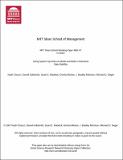| dc.description.abstract | The world can be complex and dangerous - the loss of state stability of countries is of
increasing concern. Although every case is unique, there are important common
processes. We have developed a system dynamics model of state stability based on an
extensive review of the literature and debriefings of subject matter experts. We represent
the nature and dynamics of the ‘loads’ generated by insurgency activities, on the one
hand, and the core features of state resilience and its ‘capacity’ to withstand these
‘loads’, on the other. The challenge is to determine when threats to stability override the
resilience of the state and, more important, to anticipate conditions under which small
additional changes in anti-regime activity can generate major disruptions. With these
insights, we can identify appropriate and actionable mitigation factors to decrease the
likelihood of radical shifts in behavior and enhance prospects for stability. | en |
